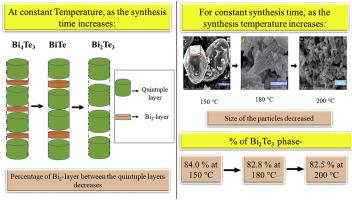Materials Today Advances ( IF 8.1 ) Pub Date : 2020-07-02 , DOI: 10.1016/j.mtadv.2020.100082 V. Thakur , K. Upadhyay , R. Kaur , N. Goyal , S. Gautam

|
The optimization of secondary phase in thermoelectric (TE) materials can help to improve the efficiency of the material. Being a potential candidate for lower temperature TE application, bismuth telluride (Bi2Te3) nanoparticles were synthesized via different routes and profiles to optimize their pure single phase. Systematic characterizations were performed with the help of X-ray diffraction (XRD), Rietveld refinement, and field effect scanning electron microscopy (FE-SEM) for structural and morphological behaviors, while TE properties such as Seebeck coefficient, electrical conductivity, and power factor were measured for the purest sample chosen. Rietveld refinement in the XRD pattern of the samples revealed that only a small amount ( 1.6%) of Bi2Te3 was formed in the coprecipitation method, while the hydrothermal technique increases this phase with increment in synthesis duration. This work focused on the phase evolution of Bi2Te3 with increasing synthesis duration time at constant temperature and vice versa. XRD and Rietveld refinement revealed that the hydrothermal technique (150°C for 48 h) can synthesize purest samples (84% Bi2Te3 phase in this case). FE-SEM and energy-dispersive X-ray analysis also indicated that the impure phase in the system is decreased along with an atomic percentage of oxygen from 37% to 11% and decreases in particle size with increase in temperature in case of hydrothermally synthesized samples. Decrease in the size of the particle, with an increase in synthesis temperature, shows a decrease in percentage abundance of Bi2Te3 phase due to surface Te desorption. The observed electrical conductivity is 20 times greater, while Seebeck coefficient is 3 times lower than that of the pure Bi2Te3 phase. The detailed analysis has generalized the growth mechanism in Bi2Te3 phase evolution by the diffusion of Bi into Te nanorods to fabricate hexagonal Bi2Te3, and Te-desorption from the surfaces of these particles.
中文翻译:

研究Bi-Te热电系统的相变和形态
热电(TE)材料中第二相的优化可以帮助提高材料的效率。碲化铋(Bi 2 Te 3)纳米粒子作为低温TE应用的潜在候选者,通过不同的途径和分布合成了纳米晶,以优化其纯单相。借助X射线衍射(XRD),Rietveld精细化和场效应扫描电子显微镜(FE-SEM)进行了系统表征,以表征结构和形态,而TE特性(例如塞贝克系数,电导率和功率因数)对所选的最纯样品进行测量。样品的XRD图谱的Rietveld精炼显示,只有少量(共沉淀法形成了1.6%的Bi 2 Te 3,而水热技术随着合成时间的延长而增加了该相。这项工作的重点是在恒定温度下Bi 2 Te 3随着合成持续时间的增加而发生相变,反之亦然。XRD和Rietveld精炼显示,水热技术(150°C持续48 h)可以合成最纯的样品(84%Bi 2 Te 3在这种情况下)。FE-SEM和能量色散X射线分析还表明,在水热合成样品的情况下,系统中的不纯相随着氧的原子百分比从37%降低到11%并随着温度的升高而减小了粒径。随着合成温度的升高,颗粒尺寸的减小表明由于表面Te的解吸,Bi 2 Te 3相的丰度百分比降低。观察到的电导率为大20倍,而塞贝克系数为 比纯Bi 2 Te 3相低3倍。详细的分析通过Bi扩散到Te纳米棒中以制造六角形Bi 2 Te 3以及Te从这些颗粒的表面脱附,从而概括了Bi 2 Te 3相演化的生长机理。











































 京公网安备 11010802027423号
京公网安备 11010802027423号